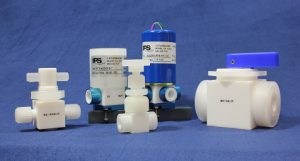Bicycle pumps, dental drills and jackhammers all have one thing in common: They are everyday examples of pneumatic machines.
Even in industrial settings, where pneumatic systems run complex functions, pneumatic machines of all types use the same components to generate and use compressed air to perform. They are:
- Compressor
- Reservoir
- Valve
Although compressors and reservoirs can vary, their basic functions do not: They create and hold pressurized air. The same cannot be said of valves. All valves used in pneumatic systems control or modulate airflow based on the needs of the system, but there are several configurations to consider.
The Basics of Pneumatic Valves
Below are the most common types of valves used within pneumatic systems.
Pressure Relief Valves:
Pressure relief valves do exactly as the name suggests: They control pressure by opening and closing the chamber through which pressurized air moves. They automatically open at a set pressure and automatically close once air pressure drops below a specific point. Pressure relief valves are a fail-safe to prevent equipment failure resulting from excess pressure caused by such things as temperature increases and control valve malfunction.
Flow Control Valves:
Flow control valves control air velocity through pneumatic systems and are useful for controlling flow rate from the actuator, the part within pneumatic systems that converts air pressure into motion. Flow control valves adjust airflow in one direction, allowing air to flow freely in the opposite direction. Check valves, a type of flow control valves, allow air or gas to move in one direction only to prevent backflow.
Quick Exhaust Valves:
Quick exhaust valves consist of an input, an outlet and an exhaust. Quick exhaust valves work by providing a rapid exhaust of controlled air when placed directly onto an air cylinder after the control valve.
Directional Control Valves:
Directional control valves change the direction of pressurized air.
Two-, three- and four-way valves are common in industrial pneumatic systems. Directional control valves show the number of positions, the methods of actuation, the number of ports and the paths air can take.
Valves perform essential functions in every pneumatic system. Our knowledgeable staff has years of experience to help you get what you need. Give us a call at 435.783.6040 or request a free quote.

